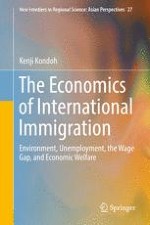2017 | OriginalPaper | Chapter
12. International Integration with Heterogeneous Immigration Policies
Author : Kenji Kondoh
Published in: The Economics of International Immigration
Publisher: Springer Singapore
Activate our intelligent search to find suitable subject content or patents.
Select sections of text to find matching patents with Artificial Intelligence. powered by
Select sections of text to find additional relevant content using AI-assisted search. powered by
